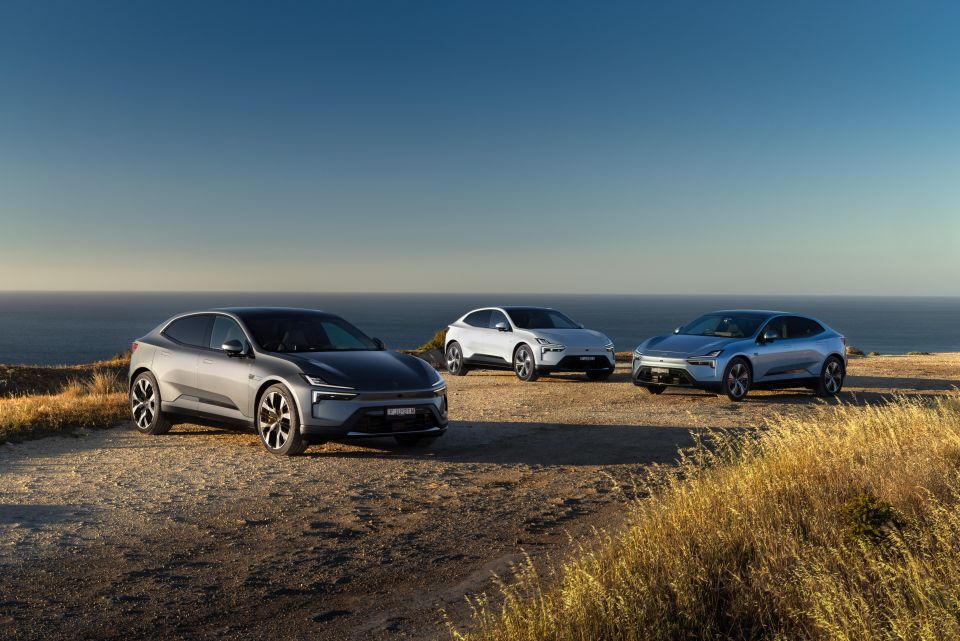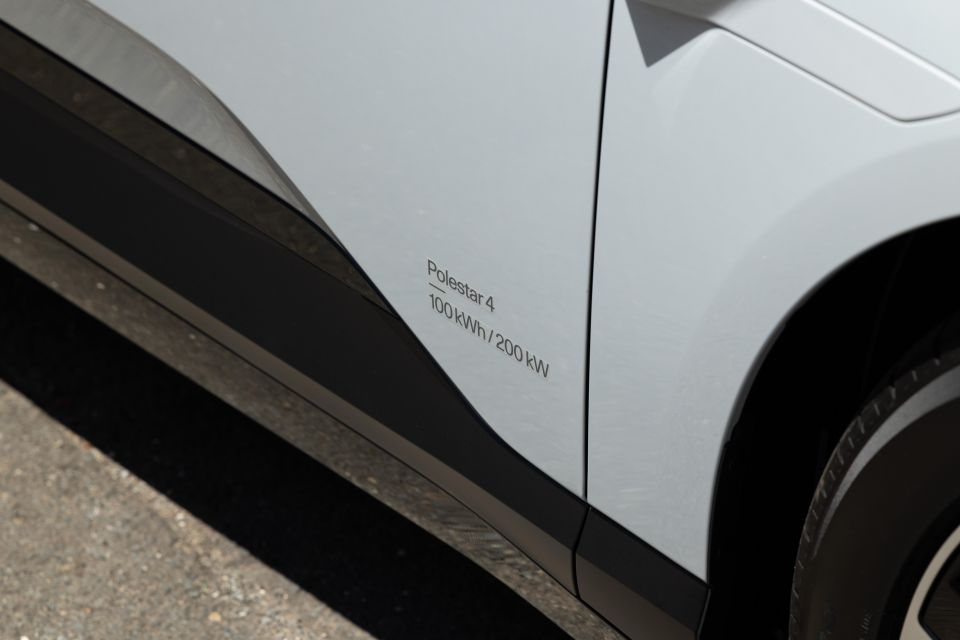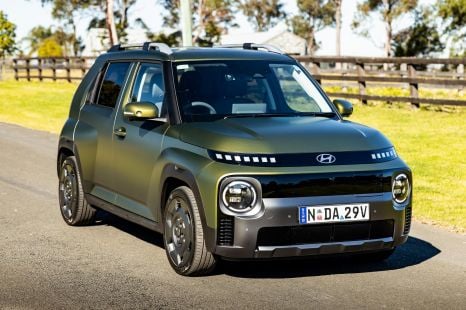

William Stopford
15 Days Ago
Polestar has dumped the rear window for its newest EV, but there's plenty of substance to go with this sleek mid-sized SUV's unique design.



Marketplace Editor

Marketplace Editor


Marketplace Editor

Marketplace Editor
Take advantage of Australia's BIGGEST new car website to find a great deal on a Polestar 4.
Polestar’s aptly-named fourth model has arrived in Australia, and it might be an adjustment for those who are used to looking over their shoulder.

The 2025 Polestar 4 has sparked controversy over its design, a highlight of which is the removal of a conventional rear window and the exclusive use of a camera to ‘see’ directly behind you.
Why? The company’s designers wanted to maximise headroom for rear passengers without sacrificing the coupe-like roofline of this edgy new mid-sized electric SUV, so by removing the rear window the roofline could be extended and raked at a more dramatic angle.
Despite its numerical name suggesting it is larger than the existing Polestar 2 fastback and Polestar 3 large SUV, the Polestar 4 actually slots between the smaller sedan and bigger SUV in the brand’s all-EV lineup, both in terms of size and pricing, and it also sits between more mainstream mid-sized electric crossovers like the Tesla Model Y and Kia EV5, and premium contenders like the new Porsche Macan Electric.
Polestar won’t be drawn on calling out direct competitors or which models it is targeting locally, but it is trying to cement itself as a premium EV brand founded on its history in engineering and motorsport. It’s also going hard on sustainability, with a number of eco-friendly materials and processes employed to reduce environmental impact.

The Sino-Swedish brand has big plans moving forward too, with the 4 being the latest in a number of new models to be released between now and 2026. The Polestar 5 grand tourer and Polestar 6 sports car are both on their way in the coming years. It’ll also be doubling its physical sales footprint in Australia in the new year.
So, is this new rear windowless electric crossover worth your attention? We joined the Australian media launch in South Australia to find out.
Pricing was recently adjusted for the 2025 model year (MY25) Polestar 4, resulting in a $3000 discount across the lineup.

| Model | Price before on-road costs |
|---|---|
| 2025 Polestar 4 Long range Single motor | $78,500 |
| 2025 Polestar 4 Long range Dual motor | $88,350 |
To see how the Polestar 4 lines up against the competition, check out our comparison tool
The Polestar 4’s sleek exterior design may be a little unconventional and polarising, but its interior is quite a bit more inviting and should have much broader appeal.

Like many other manufacturers, Polestar has been reducing physical buttons and rotary controls in its cabins; but unlike many of them the Chinese-owned Scandinavian carmaker has put plenty of thought into how it can retain strong ergonomics and user-friendliness at the same time.
There’s a big 15.4-inch central touchscreen running Polestar’s software interface based on the Android Automotive operating system with Google built-in – meaning access to a range of internet-based features and services like the intelligent Google Assistant, Google Maps, and apps from the Google Play Store.
Polestar’s head of user experience (UX), Antonio Cobaleda Cordero, told us he and his team really paid attention to grid-style layouts and evenly distributed tiles and text to make the infotainment system as easy to read and use as possible. Mr Cobaleda Cordero also noted the flat menu structure to minimise menu diving on the move.
The result is a very tablet-like experience, with great simplicity but also extensive functionality. You rarely have to make more than one press to get to where you want, and the clean layout and typeface is wonderfully easy to read.

Further, there are funky little animations and explainers if you want a more detailed description of things like the driver assistance systems.
You can also toggle a range of ambient lighting settings which are all planet-themed – the Uranus theme was weirdly popular among other journalists…
Ahead of the driver there’s also a thin 10.2-inch digital instrument cluster that’s not too different to what you’ll find in the new Volvo EX90.
It packs a bit of configurability despite its letterbox aspect ratio, offering a selection of views including a full Google Maps navigating screen in between your power and speed readouts.
The sporty front seats are comfortable and available in an array of sustainable materials. As standard, the driver’s seat offers eight ways of power adjustment, while the front passenger pew offers six ways.


The driver also gets a memory function, and the front row is heated as standard. You can upgrade to 12-way electrical adjustment including base cushion extension as part of the Plus Pack ($8000), which also adds a heated steering wheel and rear seats. Further, the Nappa upgrade ($7000, requires Plus Pack) adds ventilated front seats, among other items.
As standard, there’s Charcoal “bio-attributed MicroTech” upholstery, with options including a sustainable SoftTech knit trim made from 100 per cent recycled PET yarn as well as the aforementioned Nappa upgrade, which is also of the sustainable Bridge of Weir variety.
The knitted material comes as part of the Plus Pack, adorning just the dashboard with the black interior option, or both the seats and dashboard with the ‘Mist’ colourway. It’s a very interesting material, and has a cool 3D structure to the design that plays with the ambient lighting nicely.
While the general feeling of material quality was pretty good in the cars we drove at the press launch, we noticed some inconsistent gaps between where the dashboard insert joins with the doors at either end, and the colouring of the knit material looked slightly off as well.
Otherwise, this China-made crossover feels pretty well put together, with its straight lines and padded surfaces making for an interior that feels spacious and sturdy. The Volvo ties continue to bring a sense of solidity to the limited switchgear, namely the chunky volume dial on the centre console, which feels like it’s fashioned from glass and metal.

Storage up front is decent without being exemplary. The skinny door pockets and shallow phone holder with Qi wireless phone charger make the deep centre console cubby and under-console storage unit seem that much bigger.
There are also a couple of toothed cupholders between the front seats, but they’re of slightly different sizes which can be annoying if you and your front passenger are both carrying larger cups or bottles.
Now for the second row. While coupe-style SUVs aren’t known for their exemplary rear accommodation, Polestar’s deletion of the rear window was an attempt to specifically address this. By removing the rear windscreen, it says it was able to extend the roofline and in turn improve rear headroom, while the massive 2999mm wheelbase ensures good knee and leg room.
I can confirm it’s almost limo-like in the back, where there’s heaps of knee and leg room for 6’1″ me behind my own driving position, and decent headroom under the fixed glass roof. Even better, the rear backrests are electrically reclinable if you opt for the Plus Pack, which is a really cool touch.


Rear air vents are standard, mounted on the B-pillars as well as the rear of the centre console, and you also have the option of a third zone of climate control as part of the Plus Pack.
There’s no standard shade for the fixed glass roof, though you can option an electrochromic roof for $2700 (though it requires the Plus Pack) and a clip-in shade is available as an accessory for $300 – seems a bit stiff, really.
Behind the rear seats, which can be separated by a folding bulkhead-style multifunction armrest, there’s a 526-litre boot that is not only spacious but also nicely square, including 31L under the floor. Fold the rear seats down and you have 1536 litres.
As is the case with a number of EVs on the market, there’s no spare wheel in the Polestar 4 regardless of the wheel and tyre package chosen.


| Dimensions | Polestar 4 |
|---|---|
| Length | 4840mm |
| Width | 2139mm – incl. mirrors |
| Height | 1534mm |
| Wheelbase | 2999mm |
| Cargo capacity | 526 litres incl. 31L under floor – rear seats up 1536 litres incl. 31L under floor – rear seats folded |
To see how the Polestar 4 lines up against the competition, check out our comparison tool
The Polestar 4 offers two drivetrain options and one battery variant.

| Specifications | Polestar 4 Single motor | Polestar Dual motor |
|---|---|---|
| Drivetrain | Single-motor electric | Dual-motor electric |
| Battery | 100kWh – nominal 94kWh – usable Nickel-manganese-cobalt (NMC) | 100kWh – nominal 94kWh – usable Nickel-manganese-cobalt (NMC) |
| Power | 200kW | 400kW |
| Torque | 343Nm | 686Nm |
| Driven wheels | Rear-wheel drive | All-wheel drive |
| Weight | 2230kg | 2355kg |
| 0-100km/h (claimed) | 7.1 seconds | 3.8 seconds |
| Energy consumption (claimed) | 17.8-18.1kWh | 18.7-21.7kWh |
| Claimed range (WLTP) | Up to 620 kilometres | Up to 590 kilometres |
| AC charging capacity | Up to 22kW | Up 22kW |
| AC charging time | 5.5 hours (0-100 per cent) | 5.5 hours (0-100 per cent) |
| DC charging capacity | Up to 200kW | Up to 200kW |
| DC charging time | 30 mins (10-80 per cent) | 30 mins (10-80 per cent) |
Our reasonably dynamic drive route wasn’t necessarily indicative of real-world efficiency, though we saw the Single motor’s indicated readout showing 19kWh/100km, while the Dual motor with Performance Pack returned around the 21-22kWh mark with a heavier right foot.
Both figures are pretty close to their respective manufacturer’s claims despite the enthusiastic driving style and environment, and given the size and category of this vehicle, both results are pretty good – though it won’t be giving a Model Y any sleepless nights on the efficiency front.
With more urban roads and more opportunities for energy regen, I’d imagine both variants would get much closer to their respective efficiency and range claims, making a real-world range of over 500km entirely achievable.
To see how the Polestar 4 lines up against the competition, check out our comparison tool
It may not look it, but this is quite a substantial vehicle in terms of its dimensions.

You really do get the impression of width in the Polestar 4, but as you start to get a feel for it this 4.8m-long, 2.1m-wide (including mirrors) ‘wagon’ starts to shrink around you.
A lot of that is down to its overall dynamic ability. The weighty and direct steering gives it a keen feel from behind the wheel, making it handle like a smaller and more nimble vehicle.
Our drive took us from the streets of Adelaide into the Barossa Valley via the Adelaide Hills, giving us a good mix of city and suburban streets, plus twisty B-roads, and a bit of country highway.
We started off in the Long range Single motor, which had the optional Plus Pack with the Mist-coloured knitted upholstery.

Through the streets of Adelaide the smaller 20-inch alloys and chubbier 255/40-profile rubber made light work of the sort of road imperfections you encounter in suburbia.
Like a number of European products, the Polestar 4 has a firmer edge to its damping, but it’s otherwise very compliant and offers a good amount of travel in the suspension without feeling too loose.
Performance in the base model is more than adequate for normal driving, with 200kW on tap and, more importantly, 343Nm available from standstill to get this 2.2-tonne machine moving at a decent clip.
That said, Polestar and Volvo tend to calibrate a bit of doughiness into the initial throttle response to provide smoother torque delivery off the line and avoid jolty initial takeoff. Personally, I prefer the smooth setup but would appreciate a bit more initial response.

Find out more about the car
Once we got out of town the Polestar 4’s sure-footed road holding and wide stance translated to a more athletic drive experience, with the car’s rear-drive balance providing for a classic premium sports sedan-like feel – with a slightly raised ride height, of course.
I really like the heft of the steering calibration in the 4, which is much like that of the 2. It’s a little heavier than you’d expect, but it offers good feel and quick response – as I said earlier, it kind of shrinks around you.
The smaller-wheeled Single motor wasn’t quite at home on some of the high-speed undulating roads approaching the Barossa, however, with its softer passive tune not feeling as settled or quick to recover as the Performance Pack-equipped Dual motor model we subsequently drove with its firmer adaptive suspension setup.
Still, if you’re inclined to enjoying a more comfortable experience from the driver or passenger seat, the standard specification with smaller wheels strikes a nice balance for most scenarios.

You can have the Dual motor with basically the same specification as the Single motor, though the test car we drove was heavily optioned with packages, including the Performance Pack, which changes its character a bit.
The Dual motor adds three-stage adaptive damping as standard, and the Performance Package brings an even more focused Polestar Engineered tune for the configurable chassis settings, in addition to larger wheels, performance tyres and Brembo brakes with Swedish Gold calipers.
Right away, you can feel the more focused setup, especially on the sort of roads we were on, and the grippier rubber sends a bit more tyre noise into the cabin – particularly in the rear, where I rode for my passenger leg of the drive.
Minor drawbacks aside, this specification is tangibly more driver-focused, and makes the Dual motor version a pretty quick and capable electric GT.

It’s worth remembering the Polestar 4 Dual motor is the brand’s quickest production model yet, claiming a 3.8-second 0-100km/h run – which feels very accurate by the seat of the pants – and in hero Performance Pack spec it’s certainly a fast and involving drive for something so large.
On an additional loop later in the day, I drove this same spec with a bit more anger on a half-hour route incorporating some twisty bits and high-speed country highway sections, and it again proved itself as a capable fast tourer, but it also left me wondering if all this was really necessary.
Why? Because this is a 2.3-tonne (in Dual motor-spec) coupe-crossover that will likely spend most of its time tootling around town rather than tearing up windy B-roads away from suburbia. This more focused – and more expensive – derivative, while fun and involving to drive, is bordering on overkill given the base car is already quite good.
For reference, the Performance Pack is a $7200 option on top of the $8000 Plus Pack, so to get these upgrades it’ll cost you a minimum of $15,200 on top of the Dual motor’s $88,250 list price before on-roads – making it a six-figure car before you even think about the $7000 Nappa upgrade also fitted to this particular test vehicle.
Still, that’s much cheaper than the new Porsche Macan Electric, which in Turbo guise starts from a cool $180,000.

From a safety assistance perspective, the driver-focused route meant we weren’t really in scenarios where Pilot Assist was appropriate, though we did put the cameras to work when parking and, obviously, that rear-view mirror.
I expected the lack of a rear window to be a problem from the driver’s seat, but only until I attempted to reverse park and had the realisation it was useless looking over my shoulder; it’s very easy to forget there’s no window there.
Polestar says the 4 is the first car to use the second-generation camera technology from Gentex for its digital rear-view mirror, which incorporates a 2.5-megapixel high-definition camera mounted where a shark-fin antenna would normally go.
The company says the high dynamic range and custom image processing improves visibility across all lighting conditions, and offers a wider field of view than a conventional mirror through a traditional rear window.

When quizzed about the placement of the camera and the risk of it getting dirty or damaged, the 4’s product manager Ola Aldensjö said the camera’s positioning on the rear roof and the housing’s lipped border helps mitigate the risk of it getting dirtied by rain and grime, or damaged by debris.
Beyond the digital rear-view mirror, the Polestar 4 is equipped with a litany of cameras (11) and sensors (12) around the vehicle. The standard surround parking camera is good, but its bird’s-eye view can suffer from the slightly warped display we’ve seen in other Polestar and Volvo products.
We didn’t experience any issues with the driver monitoring system, which didn’t have overzealous tendencies like we’ve endured in vehicles from other – namely Korean and Chinese – brands.
To see how the Polestar 4 lines up against the competition, check out our comparison tool
The Polestar 4 is available in two variants in Australia.




Polestar 4 Long range Single motor highlights:
Polestar 4 Long range Dual motor adds:
To see how the Polestar 4 lines up against the competition, check out our comparison tool
A number of packages and standalone options are available for the Polestar 4.


Pro Pack: $2500
Plus Pack: $8000
Performance Pack: $7200 (Dual motor with Plus Pack)
Nappa upgrade: $7000 (requires Plus Pack)
Single item options:
To see how the Polestar 4 lines up against the competition, check out our comparison tool
The Polestar 4 is yet to receive a safety rating from ANCAP or Euro NCAP.

Standard safety features include:
To see how the Polestar 4 lines up against the competition, check out our comparison tool
The Polestar 4 is sold in Australia with a five-year, unlimited-kilometre warranty.

| Running costs | Polestar 4 |
|---|---|
| Warranty | 5 years, unlimited kilometres – vehicle 8 years or 160,000 kilometres – EV battery |
| Roadside assistance | 5 years |
| Service intervals | 12 months or 20,000 kilometres |
| Capped-price servicing | 5 years or 100,000 kilometres |
| Total capped-price service cost | Free |
There is also a 12-year warranty against corrosion, while three years of complimentary Polestar Connect and five years of roadside assist are included in the purchase price.
While the free servicing package is a healthy saving, it’s a shame there’s no partnership with a public charging provider to help new EV customers ease into using Australia’s often flawed charger network.
To see how the Polestar 4 lines up against the competition, check out our comparison tool
It may look awkward from some angles, but I came away quite impressed with the Polestar 4.

Should you enjoy its distinctive exterior, you’ll be even more impressed with the classy cabin, the surprising amount of space for passengers and their cargo, the user-friendly tech, and the engaging drive experience.
It’s also got a long range that’s achievable in the real world, though the 200kW DC charging capacity is a little off the pace compared to some other brands in the EV space – noting that 100kWh is quite a big battery to re-juice.
While the lengthy options list is annoyingly pricey, it conversely allows owners to really make the car their own with their ideal combination of add-ons, or just keep it simple with the already decent standard specification.
You also get a pretty sweet deal with free servicing for five years or 100,000km; which is longer than the life of most finance or lease periods anyway.

Polestar has a bit of work to do in Australia though. The brand’s commitment and transparency around holistic sustainability is a great point of difference, but it’s still a largely unknown entity to the general public Down Under and, for many, its designs could still be confused with those from Volvo.
However, a bigger dealer network in 2025 will improve Polestar’s brand recognition, as will a broader product portfolio led by the 4, which is expected to be its top-seller. As the brand’s first entry in Australia’s single biggest new-vehicle sales segment, the Polestar 4 will be a better test of how many people its dealers can convert to customers, and whether many will simply end up on Hertz rental fleets like the 2.
My pick? The Single motor with the Plus Pack and privacy glass comes in at just under $100,000 drive-away, even with the beautiful (but exxy) $2300 Snow white paint.
That gives you all the cool features like Pixel LED headlights, Harman Kardon audio, knitted upholstery, and power-reclining rear seats, while also offering the best balance of performance and range.

Interested in buying a Polestar? Get in touch with one of CarExpert’s trusted dealers here
Click the images for the full gallery
MORE: Everything Polestar 4
Take advantage of Australia's BIGGEST new car website to find a great deal on a Polestar 4.
James is an automotive journalist based in Melbourne, Australia. Before joining CarExpert.com.au in 2020, James has worked at leading auto media outlets including Carsales and CarAdvice, as well as at Pulse agency for Ford Australia's communications team. In 2019 James made Mumbrella's 'Top 20 most prolific web authors in Australia' list after publishing 1,360 articles between March 1, 2018 and February 28, 2019 for CarAdvice. James is also an Ambassador for Drive Against Depression – an Australian charity whose mission is to support mental wellness through the freedom of driving and a shared love of cars.


William Stopford
15 Days Ago


Damion Smy
14 Days Ago


Max Davies
13 Days Ago


William Stopford
13 Days Ago


Alborz Fallah
10 Days Ago


Matt Campbell
9 Days Ago